
After the People’s Climate March, the struggle for environmental justice continues at Buzzard Point, DC.
On April 29, 200,000 climate activists descended on DC for the People’s Climate March, a demonstration of unity for jobs, justice, and climate action. “We resist, we build, we rise,” protesters chanted. What happens, though, after those activists have gone home?
Environmental injustices continue in the city where hundreds of thousands of activists just marched.
Buzzard Point, a majority low-income African American community in southwest DC, is at risk of riverine and coastal flooding due to climate change. Of the ward’s 84,000 residents, 93.3 percent are people of color.
A series of development projects like the DC United Soccer Stadium, while at face value a boon for economic growth, unearth decades of toxicity in Buzzard Point, exposing community members to harmful substances while at the same time threatening to push out low- and middle-income residents.
On December 30, 2014, the DC Council formally approved the Soccer Stadium Development Act, paving the way for a new state-of-the art stadium in Buzzard Point. The Council amended and restated this agreement in June 2015. It filed for eminent domain that September to acquire site control, and broke ground in April 2016. The 20,000-seat stadium is planned to open in 2018.
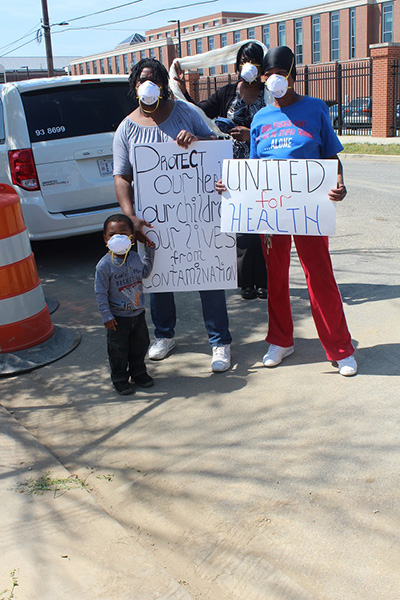 April 25, 2016, protest of soccer stadium groundbreaking residents from Syphax Gardens, Q St. Corridor and Greenleaf. (Photo: Kari Fulton)In the face of development projects like DC United, Buzzard Point is a community on the frontlines of environmental degradation. Residents must contend with uncertainty about their future, procedural tensions with the city with respect to community representation during this process, and the toxic impacts of development on their health.
April 25, 2016, protest of soccer stadium groundbreaking residents from Syphax Gardens, Q St. Corridor and Greenleaf. (Photo: Kari Fulton)In the face of development projects like DC United, Buzzard Point is a community on the frontlines of environmental degradation. Residents must contend with uncertainty about their future, procedural tensions with the city with respect to community representation during this process, and the toxic impacts of development on their health.
Buzzard Point residents experience high rates of cancer and asthma linked to poor air quality from industrial sites like the cement plant and Pepco Buzzard Point Substation.
After living in Buzzard Point for 30 years, Advisory Neighborhood Commissioner Rhonda Hamilton (ANC 6D06) has witnessed firsthand the deep impacts of industrial toxicity on her community. “People who come to our area, who don’t have asthma, who don’t have allergies, all of [a] sudden, within two to three months, they’re asthmatic and have severe allergies and they’re back and forth to the doctor,” she said.
Residents under the age of 18 have a 14-15 percent prevalence of asthma, which is 1.5 times the prevalence rate in the rest of southwest DC. Diesel fumes from construction trucks passing through the area contribute to air quality concerns. At peak development, Buzzard Point is predicted to have 250-300 trucks passing through daily.
Ten percent of adults in Buzzard Point have chronic obstructive pulmonary disease. The rate in surrounding neighborhoods is only 1 percent. Adult residents have a 24 percent chance of having bad health for longer than two weeks, compared to a 7 percent chance in surrounding neighborhoods.
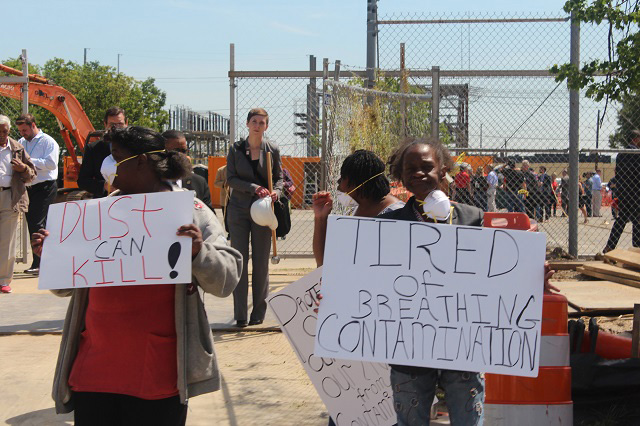 April 25, 2016, protest of soccer stadium groundbreaking residents from Syphax Gardens, Q St. Corridor and Greenleaf. (Photo: Kari Fulton)
April 25, 2016, protest of soccer stadium groundbreaking residents from Syphax Gardens, Q St. Corridor and Greenleaf. (Photo: Kari Fulton)
To make matters worse, 20 percent of the Buzzard Point population doesn’t have health insurance, compared to the 2-10 percent of residents in surrounding areas who lack health insurance.
The majority of housing in Buzzard Point consists of low-rise homes without central ventilation. Air containing diesel fumes from constant traffic, fugitive dust from the cement factory, and toxins from the area’s many construction projects poison residents, both indoors and outdoors. Opening a door or window, or turning on an air conditioning unit means breathing in a toxic cocktail of chemicals, including diesel fumes, bisphenol A and arsenic. Toxic soil release is also a cause for concern.
With every construction project, including the DC United Stadium and Pepco Substation, residents like Hamilton have noticed an accumulation of dust in their homes. Hamilton calls this the “wind-tunnel effect of chemicals,” which is exacerbated by the fact that Buzzard Point is on a peninsula, and is one of the main arteries to DC’s city center. In Buzzard Point, there’s no escaping poor air quality.
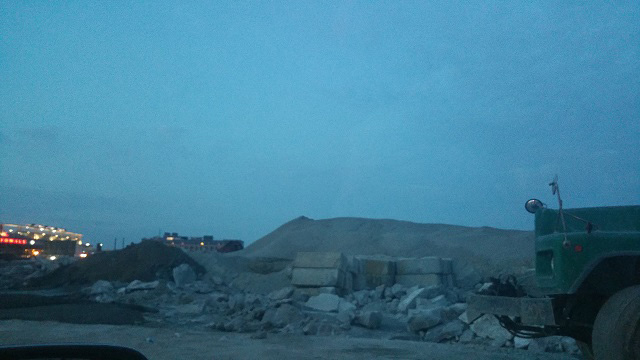 Superior Concrete plant in the industrial zone of Buzzard Point, 2017. (Photo: Kari Fulton)
Superior Concrete plant in the industrial zone of Buzzard Point, 2017. (Photo: Kari Fulton)
After significant pressure from the community, DC United agreed to provide $50,000 towards air purifiers for nearby homes. DC United has held meetings with the community to address some of their environmental concerns. Hamilton, however, was hoping for much more comprehensive results.
“We asked [the Deputy Mayor’s office] for a health advocate to work with the community and advocate for us with the different entities that are doing the environmental damage,” Hamilton said. “We were not provided with that. We asked for the cement factory to be hosed down continuously and blacktop pavement to be put in to reduce the dust. That has not been the case.”
The District Department of Energy and Environment recently installed an EPA certified air quality monitor on the roof of King Greenleaf Recreation Center, as promised in community meetings.
Yet, Hamilton said, the city and contractors need to ensure transparency and support for the community over the long haul.
“We don’t just want to know that the air is bad,” she said. “We want to know: what are the long term effects?” According to Hamilton, long-term solutions and long-term support are not a priority for the city or the construction projects.
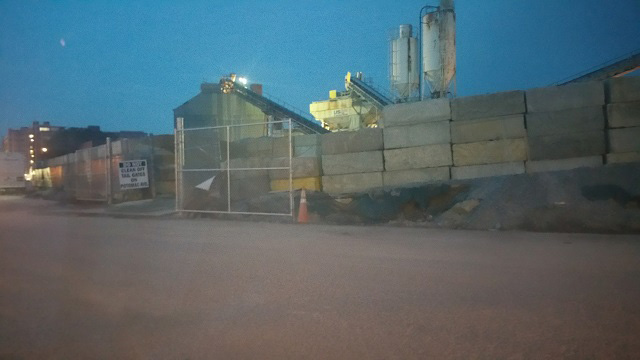 Superior Concrete plant in the industrial zone of Buzzard Point, 2017. (Photo: Kari Fulton)
Superior Concrete plant in the industrial zone of Buzzard Point, 2017. (Photo: Kari Fulton)
Hand-in-hand with concerns about toxicity are concerns about gentrification.
Kari Fulton is an environmental justice organizer working to establish the Near Buzzard Point Residents Advisory Committee. “There’s a huge fear of displacement,” Fulton said. “I was just meeting with a community member and she asked, ‘Do you think that we’re going to still be here when it’s all said and done?’ I said: ‘There is an effort to save public housing but affordable private housing is dwindling in availability’.”
Fulton explained that while there has been a push to preserve some public housing in Buzzard Point, private housing is becoming unaffordable.
“We have to fight to ensure this neighborhood remains mixed income and culturally diverse, 30 to 100 years from now,” Fulton said.
Claudia Barragan, chair of the Sierra Club DC Environmental Justice Committee, echoes this concern about gentrification. “The market has raised the prices and the cost of living so high for people, so people are leaving,” she said.
Barragan noted that impacts differ starkly along lines of race and class.
“When I say ‘people,’ it’s people of color, low income families with children, and also families that have elderly members in the family that are being displaced,” she said.
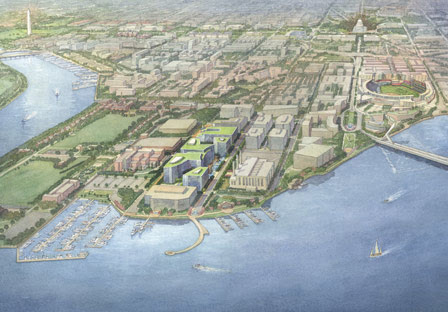 Arial view of Buzzard Point from Buzzard Point framework plan, 2015. (Photo courtesy of the DC Office of Planning) Frontlines Action
Arial view of Buzzard Point from Buzzard Point framework plan, 2015. (Photo courtesy of the DC Office of Planning) Frontlines Action
Buzzard Point residents are working to defend their community. A campaign called “Clean this Place, Don’t Displace,” spearheaded by Kari Fulton and Rhonda Hamilton, aims to secure health safeguards for air quality, and protect public housing in the changing neighborhood. Fulton’s three-year-old son came up with the slogan.
“A lot of times across the country when you remediate brownfield areas, when you clean up superfund sites, what happens is then you have a surge of revitalization/gentrification of neighborhoods and that also leads to displacement,” Fulton said. “Don’t clean up our neighborhood just to kick us out.”
So far the campaign has used tactics of recruiting community members to attend zoning commission hearings, meeting with planning teams and holding protests. While they have been able to secure funding for some air purifiers, the work of standing up for marginalized community members continues.
After the People’s Climate March: “We Gotta Keep Fighting”
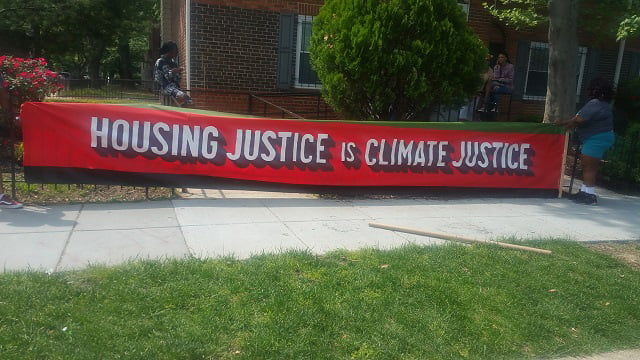 Housing Justice is Climate Justice banner in front of James Creek residents council office. (Photo: Kari Fulton)
Housing Justice is Climate Justice banner in front of James Creek residents council office. (Photo: Kari Fulton)
Fulton was part of the steering committee for the People’s Climate March. “It was a good move,” she said. “But the next day we gotta keep fighting.”
Fulton and her team of local organizers worked hard to make sure that people knew what climate justice looks like in DC. In addition to being a hotspot of toxicity in the capital, Buzzard Point is one of the areas most vulnerable to climate change.
“I still don’t think we were heard fully,” Fulton said. “We have a lot of pushing to do.”
Rhonda Hamilton was uplifted by the experience of unity that the large-scale march provided. “It really gave me hope to see thousands upon thousands of people come from different countries, different places, to meet together and to push to raise awareness about climate change,” she said. “As a community leader who cares about environmental justice, it becomes hard when you feel like you’re in this fight alone.”
After the march, Hamilton said she felt encouraged and rejuvenated.
While it’s important to acknowledge the uplifting aspects of protests, Barragan insists that to simply show up for one day in the streets is not enough.
“One day of action is very small [compared to] the actual needs [of the Buzzard Point community] when they’re addressing climate injustices on a daily basis or an hourly basis,” Barragan said. “The People’s Climate March was really important as a movement, but I’m not sure whether it trickles down to the local level, improving conditions for people who are facing those struggles.”
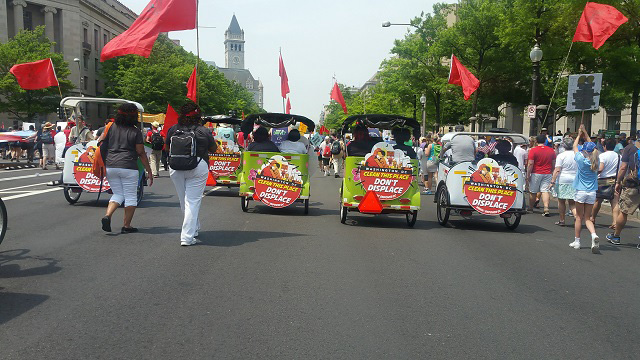 Near Buzzard Point, community members travel in pedicabs with signs attached that say “Clean this place, don’t displace.” (Photo: Kari Fulton)
Near Buzzard Point, community members travel in pedicabs with signs attached that say “Clean this place, don’t displace.” (Photo: Kari Fulton)
The takeaway: one day of action must turn into a longer-term justice movement. What, then, would environmental justice look like for Buzzard Point?
“Environmental justice would look like us being at the point where we don’t have to worry about hazards. When I wake up in the morning I don’t have to look down at a cement factory that blows fugitive dust,” Hamilton said.
Fulton hopes to see “a clean, accessible waterfront community that’s available for all, and that is not being built for luxury townhomes that aren’t accessible to anyone who doesn’t make a certain amount of money.”
The alleviation of health problems is a key component of residents’ vision for justice, as is an end to gentrification and displacement.
“Environmental justice would also look like lowered asthma rates in the community,” Fulton said. “It would look like that silly concrete yard being out of the way and not always throwing all these dust plumes into the air constantly. It would look like the residents not worrying if they’re going to be displaced.”
Hamilton added: “Environmental justice for my community would mean reassurances that our housing would not be at jeopardy once all of this is built out,” she said. Hamilton worries that her community could be exposed to asbestos from the bridge reconstruction, chemicals unearthed from remediation of the soccer stadium, and construction of a substation, only to be told to leave.
“At the end of the day, because we’re in public housing and subsidized housing, someone could come along and say, you know, we’re going to redevelop this area. You all need to get prepared to move.”
Barragan faults the city for the lack of attention paid to local concerns. “It should have been open participatory process with actual remediation efforts from the city, directly to the community,” she said. “The community has had to fight for every single thing that they’ve requested, and there was really no liaison.”
For Barragan, environmental justice is participatory justice. “The community [should] have someone advocating for them.”
Residents emphasize that Buzzard Point’s situation must be seen in a larger context. Across the country, and around the world, toxicity disproportionately impacts people of color.
“I know that we will win,” Hamilton said. “We may not win everything, but we will have some victories and we will have some gains in this, and we will be able to look to future generations and say, you know what, we’ve done the best that we can to make it better for you all. Now we will pass on the shield to you.”
We’re not backing down in the face of Trump’s threats.
As Donald Trump is inaugurated a second time, independent media organizations are faced with urgent mandates: Tell the truth more loudly than ever before. Do that work even as our standard modes of distribution (such as social media platforms) are being manipulated and curtailed by forces of fascist repression and ruthless capitalism. Do that work even as journalism and journalists face targeted attacks, including from the government itself. And do that work in community, never forgetting that we’re not shouting into a faceless void – we’re reaching out to real people amid a life-threatening political climate.
Our task is formidable, and it requires us to ground ourselves in our principles, remind ourselves of our utility, dig in and commit.
As a dizzying number of corporate news organizations – either through need or greed – rush to implement new ways to further monetize their content, and others acquiesce to Trump’s wishes, now is a time for movement media-makers to double down on community-first models.
At Truthout, we are reaffirming our commitments on this front: We won’t run ads or have a paywall because we believe that everyone should have access to information, and that access should exist without barriers and free of distractions from craven corporate interests. We recognize the implications for democracy when information-seekers click a link only to find the article trapped behind a paywall or buried on a page with dozens of invasive ads. The laws of capitalism dictate an unending increase in monetization, and much of the media simply follows those laws. Truthout and many of our peers are dedicating ourselves to following other paths – a commitment which feels vital in a moment when corporations are evermore overtly embedded in government.
Over 80 percent of Truthout‘s funding comes from small individual donations from our community of readers, and the remaining 20 percent comes from a handful of social justice-oriented foundations. Over a third of our total budget is supported by recurring monthly donors, many of whom give because they want to help us keep Truthout barrier-free for everyone.
You can help by giving today. Whether you can make a small monthly donation or a larger gift, Truthout only works with your support.